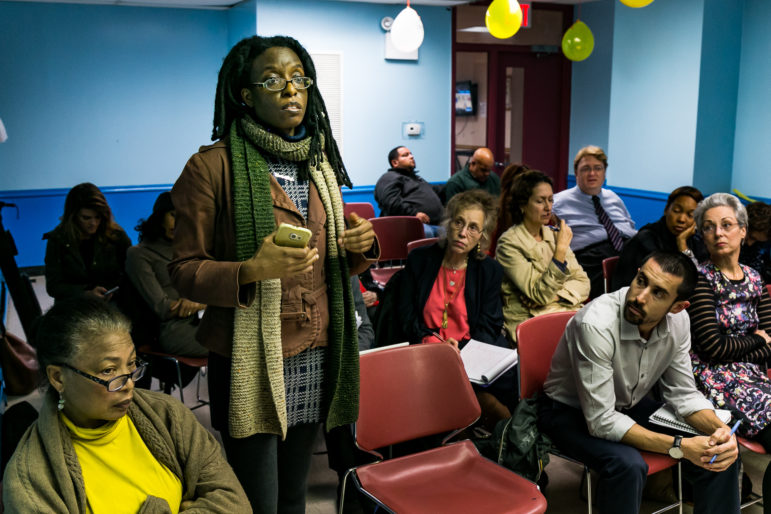
Adi Talwar
Marie Winfield. asking a question during the Department of City Planning’s presentation of it’s draft rezoning framework for East Harlem at Community Board 11’s Land Use, Landmarks & Planning Committee meeting on November 9th.
The Department of City Planning predicts its proposed rezoning of East Harlem would lead to the creation of an additional 3,494 units of housing and an additional 8,420 residents over the next 10 years, according to a key document in the project’s public review process released Thursday.
The rezoning could lead to an additional 151,061 square feet of commercial space, 98,922 square feet of community facility space, 132,394 square feet of industrial space, and 1,479 new jobs, according to the new assessment.*
Those projections are found in the “draft scope” (which can be viewed ” target=”_blank”>here), a document describing the details of a land-use action and outlining the methods the city will use to study the project’s potential impacts, which will be described in an Environmental Impact Statement (EIS). The city must release a draft EIS before it can launch the Uniform Land Use Review Procedure (ULURP), the multi-step public review process required to legalize a land-use change. DCP’s predictions are based on an assessment of development trends and other factors.
Under the city’s new mandatory inclusionary housing policy, at least 20 to 30 percent of the 3,494 units would be rent-restricted units, with possibly more if developers agree to rent-restrictions in exchange for subsidies.
The draft scope also notes that the Department of Housing, Preservation and Development (HPD) is seeking a developer to build 100 percent below-market housing on a block between East 111th street, East 112th Street, Park Avenue, and Madison Avenue known as the “East 111th Street Site.” The draft scope predicts that this site could bring an additional 668 units of affordable housing and an additional 1,610 people.
East Harlem is already considered one of the top five gentrifying neighborhoods in the city by the NYU Furman Center. Between 1990 and 2010-2014, the neighborhood’s average rents increased by more than 40 percent, and the New York Post reports that the opening of the Second Avenue subway line will likely boost rents in the surrounding area in years to come.
Depending on how you look at it, a proposed rezoning could either be a necessary precaution, creating permanent below-market housing in areas where there are currently no enforceable requirements for permanent affordable units, or a boon to developers looking to take advantage of East Harlem’s hot market and a catalyst for rent increases in existing buildings.
At least some feels it’s the former. They’re holding a press conference on Monday at 1 p.m. at 18 East 116th Street. Members of N.E.R.V.E. Inc., South Bronx Community Congress, El Barrio Unite, East Harlem Preservation and others will announce their opposition to the plan.
As City Limits reported in October, DCP says its rezoning proposal for the neighborhood mirrors the zoning suggestions outlined in the East Harlem Neighborhood Plan, a comprehensive document produced by City Council Speaker Melissa Mark-Viverito and a large team of local organizations last February.
While it’s true there are many similarities, there are also major differences, including bigger buildings along Third Avenue and parts of Park Avenue. In addition, the East Harlem Neighborhood Plan called on the city to develop public land, including six properties identified in the plan, with below-market housing in order to ensure that 50 percent of the total housing created through the rezoning would be affordable to current area residents, including at least 20 percent of units for families making below 30 percent of area median income. It is not yet clear how the de Blasio administration proposal will match up.
One of those six sites mentioned in the neighborhood plan is the East 111th Street site that HPD is in the process of developing. One other, the district’s sanitation lot on East 99th Street, might also have potential: the Department of Sanitation is seeking to relocate its facilities to an alternative site. The other four sites have active uses, and three were left out of the rezoning area.
“We are working with HPD to make sure we can maximize affordability where possible, and on public sites, that’s the first step because we have more control of public sites than private sites,” said DCP planner Calvin Brown at the Community Board 11 Land Use, Landmarks & Planning Committee meeting on Wednesday night.
At the meeting, board members expressed a variety of concerns with the proposal, especially about the potential for displacement, the number of affordable units and the impact of greater density on parks, schools, and pedestrian traffic.
“The prospect of a district with no height limit causes great concern for a district like East Harlem,” said Matthew Washington, Deputy Borough President of Manhattan and former chairman of Community Board 11. He called on the city to scale back its proposed upzoning of Park Avenue and Third Avenue, find a way to ensure a greater percentage of permanently affordable units, and employ strategies to protect mom-and-pop business and tenants from displacement.
Board member Marie Winfield urged clarification on the future of the city’s community preference policy. That policy allows residents of a project’s community district to receive preference in the lottery for 50 percent of new below-market units, but the policy is currently facing a court challenge by advocates who say the policy perpetuates segregation.
“Given that [the rezoning] is about to go through the ULURP, we should have an answer about how the city is going to resolve this lawsuit and how it impacts this rezoning and any rezoning throughout the city,” Winfield said.
Brown emphasized DCP’s efforts to create a nuanced proposal that reflects the existing character of the neighborhood, with height limits in some areas to discourage demolition of existing buildings, and a mix of zoning designations on major avenues to encourage a range of building heights and allow light onto the street.
“I don’t want to mischaracterize what we’re doing as a one-size-fit all,” he said, explaining that the city’s plan attempts to achieve “focused growth without having as much impact on housing that may become vulnerable.”
He could not answer board members’ requests for a timeline of when they would learn about what infrastructure, including schools, will be developed to accommodate an increased population, but said that the city’s environmental review process will help to determine the need for new infrastructure.
The East Harlem Neighborhood Plan also included a suite of other recommendations on a dozen topics, from affordable housing preservation to transportation to open space. While DCP is working with other city agencies on crafting a variety of initiatives for East Harlem, those agencies have yet to publicly present plans for East Harlem. Brown acknowledged the importance of bringing other agencies to the community to facilitate a conversation about the city’s “larger plan” for the neighborhood.
*The projections cited here reflect the expected net increases over what would be developed without any rezoning. The actual totals with the proposed rezoning would be 6,055 new apartments with 14,593 new residents, 732,779 square feet of commercial space, 106,317 square feet of community facility space, 155,171 square feet of industrial space, and 3,279 new jobs.



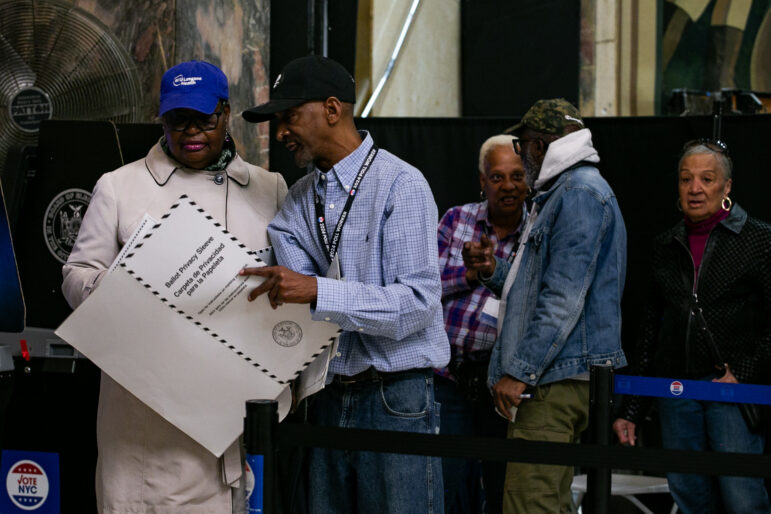
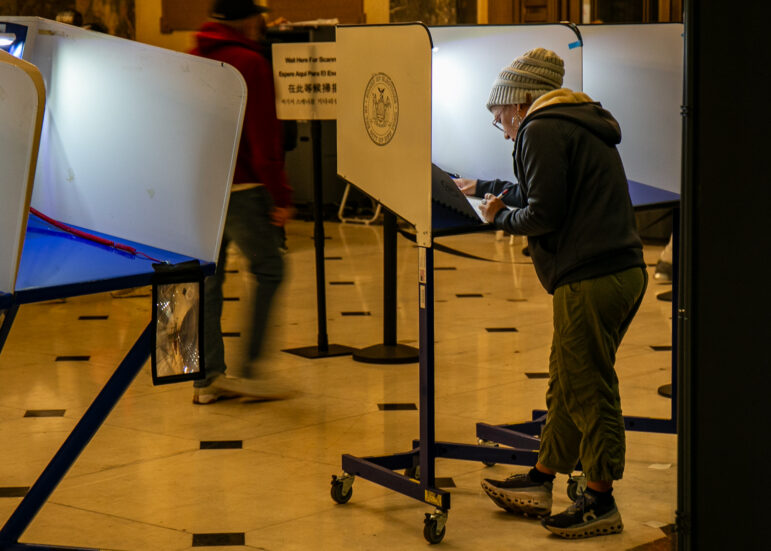
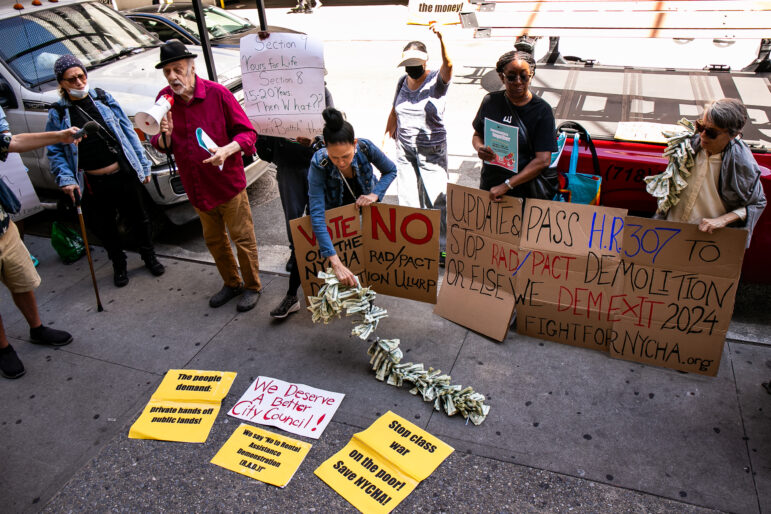
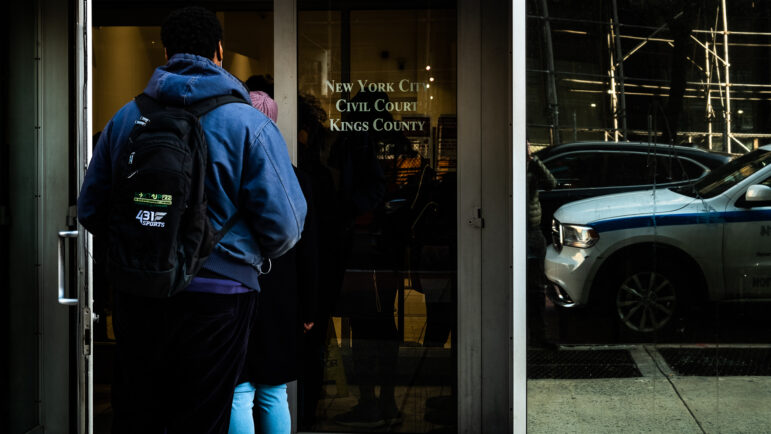


4 thoughts on “De Blasio Administration Predicts East Harlem Plan Will Make Room for 8,400 More People”
Another rezoning that the Community Board and possibly Borough President will be asked to vote on without the benefit of having the full environmental impact completed. Seems to make a mockery of a New York City Charter Mandate, even if the bites are only advisory.
Cvh is having free food rally
at RBI for Nycha residents on same date. Interesting while section 8 voucher are increasing for resident to move Into these new Development s with the likelihood they would get a section. 8 Decrease if they remain unleased by one of these new development s.
Pingback: This Week in New York City Government - Capalino + Company
Pingback: Op-ed: Rejecting the East Harlem ‘Community’ Plan | NYC Informer